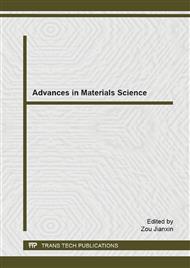[1]
Khawaji AD, Kutubkhanah IK, Wie J-M. Advances in seawater desalination technologies, J. Desalination. 221 (2008) 47-69.
DOI: 10.1016/j.desal.2007.01.067
Google Scholar
[2]
AlMarzooqi FA, Al Ghaferi AA, Saadat I, Hilal N. Application of Capacitive Deionisation in water desalination: A review, J. Desalination. 342 (2014) 3-15.
DOI: 10.1016/j.desal.2014.02.031
Google Scholar
[3]
Anderson MA, Cudero AL, Palma J. Capacitive deionization as an electrochemical means of saving energy and delivering clean water. Comparison to present desalination practices: Will it compete? J. Electrochimica Acta. 55 (2010) 3845-3856.
DOI: 10.1016/j.electacta.2010.02.012
Google Scholar
[4]
Li H, Gao Y, Pan L, Zhang Y, Chen Y, Sun Z. Electrosorptive desalination by carbon nanotubes and nanofibres electrodes and ion-exchange membranes, J. Water research. 42 (2008) 4923-4928.
DOI: 10.1016/j.watres.2008.09.026
Google Scholar
[5]
Blair JW, Murphy GW. Electrochemical Demineralization of Water with Porous Electrodes of Large Surface Area, J. American Chemical Society. 20 (1960) 206-223.
DOI: 10.1021/ba-1960-0027.ch020
Google Scholar
[6]
G.W. Murphy, D.D. Cudle. Mathematical theory of electrochemical demineralization in flowing systems, J. Electrochimica Acta. 12 (1967) 1655-1664.
DOI: 10.1016/0013-4686(67)80079-3
Google Scholar
[7]
Soffer A, Folman M. The electrical double layer of high surface porous carbon electrode, J. Journal of Electroanalytical chemistry. 38 (1972) 25-43.
DOI: 10.1016/s0022-0728(72)80087-1
Google Scholar
[8]
Oren Y, Soffer A. Water desalting by means of electrochemical parametric pumping, J. Journal of Applied Electrochemistry. 13 (1983) 473-487.
DOI: 10.1007/bf00617522
Google Scholar
[9]
Farmer JC, Fix DV, Mack GV. Capacitive Deionization of NaCl and NaNO3 Solutions With Carbon Aerogel Electrodes,J. Electrochem Soc. 143 (1996) 159-169.
DOI: 10.1149/1.1836402
Google Scholar
[10]
Mossad M, Zou LD. Evaluation of the salt removal efficiency of capacitive deionisation: Kinetics, isotherms and thermodynamics, J. Chemical Engineering Journal. 223 (2013) 704-713.
DOI: 10.1016/j.cej.2013.03.058
Google Scholar
[11]
Zhao R, van Soestbergen M, Rijnaarts HH, van der Wal A, Bazant MZ, Biesheuvel PM. Time-dependent ion selectivity in capacitive charging of porous electrodes, J. Journal of colloid and interface science. 384 (2012) 38-44.
DOI: 10.1016/j.jcis.2012.06.022
Google Scholar
[12]
Galama AH, Post JW, Stuart MAC, Biesheuvel PM. Validity of the Boltzmann equation to describe Donnan equilibrium at the membrane-solution interface, J. Journal of Membrane Science. 442 (2013) 131-139.
DOI: 10.1016/j.memsci.2013.04.022
Google Scholar
[13]
Lee J-B, Park K-K, Eum H-M, Lee C-W. Desalination of a thermal power plant wastewater by membrane capacitive deionization, J. Desalination. 196 (2006) 125-134.
DOI: 10.1016/j.desal.2006.01.011
Google Scholar
[14]
Xu P, Drewes JE, Heil D, Wang G. Treatment of brackish produced water using carbon aerogel-based capacitive deionization technology, J. Water research. 42 (2008) 2605-2617.
DOI: 10.1016/j.watres.2008.01.011
Google Scholar
[15]
Zou L, Li L, Song H, Morris G. Using mesoporous carbon electrodes for brackish water desalination, J. Water research. 42 (2008) 2340-2348.
DOI: 10.1016/j.watres.2007.12.022
Google Scholar
[16]
Zou L, Morris G, Qi D. Using activated carbon electrode in electrosorptive deionisation of brackish water, J. Desalination. 225 (2008) 329-340.
DOI: 10.1016/j.desal.2007.07.014
Google Scholar
[17]
Seo S J, Jeon H, Lee JK, Kim GY, Park D, Nojima H, et al. Investigation on removal of hardness ions by capacitive deionization (CDI) for water softening applications, J. Water research. 44 (2010) 2267-2275.
DOI: 10.1016/j.watres.2009.10.020
Google Scholar
[18]
Mossad M, Zhang W, Zou L. Using capacitive deionisation for inland brackish groundwater desalination in a remote location, J. Desalination. 308 (2013) 154-160.
DOI: 10.1016/j.desal.2012.05.021
Google Scholar
[19]
Li J, Wang X, Huang Q, Gamboa S, Sebastian PJ. Studies on preparation and performances of carbon aerogel electrodes for the application of supercapacitor, J. Journal of Power Sources. 158 (2006) 784-788.
DOI: 10.1016/j.jpowsour.2005.09.045
Google Scholar
[20]
Oh HJ, Lee JH, Ahn HJ, Jeong Y, Kim YJ, Chi CS. Nanoporous activated carbon cloth for capacitive deionization of aqueous solution, J. Thin Solid Films. 515 (2006) 220-225.
DOI: 10.1016/j.tsf.2005.12.146
Google Scholar
[21]
Ahn HJ, Lee JH, Jeong Y, Chi CS, Oh HJ. Nanostructured carbon cloth electrode for desalination from aqueous solutions, J. Materials Science and Engineering. 449 (2007) 841-845.
DOI: 10.1016/j.msea.2006.02.448
Google Scholar
[22]
Wang G, Pan C, Wang L, Dong Q, Yu C, Zhao Z, et al. Activated carbon nanofiber webs made by electrospinning for capacitive deionization, J. Electrochimica Acta. 69 (2012) 65-70.
DOI: 10.1016/j.electacta.2012.02.066
Google Scholar
[23]
Park BH, Kim YJ, Park JS, Choi J. Capacitive deionization using a carbon electrode prepared with water-soluble poly(vinyl alcohol) binder, J. Journal of Industrial and Engineering Chemistry. 17 (2011) 717-722.
DOI: 10.1016/j.jiec.2011.05.015
Google Scholar
[24]
Li HB, Lu T, Pan LK, Zhang YP, Sun Z. Electrosorption behavior of graphene in NaCl solutions, J. Journal of Materials Chemistry. 19 (2009) 6773-6779.
DOI: 10.1039/b907703k
Google Scholar
[25]
Likun Pan, Xinzheng Wang, Gao Y. Electrosorption of anions with carbon nanotube and nanofibre composite film electrodes, J. desalination. 244 (2009) 139-143.
DOI: 10.1016/j.desal.2008.05.019
Google Scholar
[26]
Li LX, Zou LD, Song HH, Morris G. Ordered mesoporous carbons synthesized by a modified sol-gel process for electrosorptive removal of sodium chloride, J. Carbon. 47 (2009) 775-781.
DOI: 10.1016/j.carbon.2008.11.012
Google Scholar
[27]
Jung HH, Hwang SW, Hyun SH, Kang-Ho L, Kim GT. Capacitive deionization characteristics of nanostructured carbon aerogel electrodes synthesized via ambient drying, J. Desalination. 216 (2007) 377-385.
DOI: 10.1016/j.desal.2006.11.023
Google Scholar
[28]
Wimalasiri Y, Zou L. Carbon nanotube/graphene composite for enhanced capacitive deionization performance, J. Carbon. 59 (2013) 464-471.
DOI: 10.1016/j.carbon.2013.03.040
Google Scholar
[29]
Wang Z, Dou B, Zheng L, Zhang G, Liu Z, Hao Z. Effective desalination by capacitive deionization with functional graphene nanocomposite as novel electrode material, J. Desalination. 299 (2012) 96-102.
DOI: 10.1016/j.desal.2012.05.028
Google Scholar
[30]
Jia BP, Zou LD. Graphene nanosheets reduced by a multi-step process as high-performance electrode material for capacitive deionisation, J. Carbon. 50 (2012) 2315-2321.
DOI: 10.1016/j.carbon.2012.01.051
Google Scholar
[31]
Li HB, Pan LK, Lu T, Zhan YK, Nie CY, Sun Z. A comparative study on electrosorptive behavior of carbon nanotubes and graphene for capacitive deionization, J. Journal of Electroanalytical Chemistry. 653 (2011) 40-44.
DOI: 10.1016/j.jelechem.2011.01.012
Google Scholar
[32]
Nie CY, Pan LK, Li HB, Chen TQ, Lu T, Sun Z. Electrophoretic deposition of carbon nanotubes film electrodes for capacitive deionization, J. Journal of Electroanalytical Chemistry. 666 (2012) 85-88.
DOI: 10.1016/j.jelechem.2011.12.006
Google Scholar


